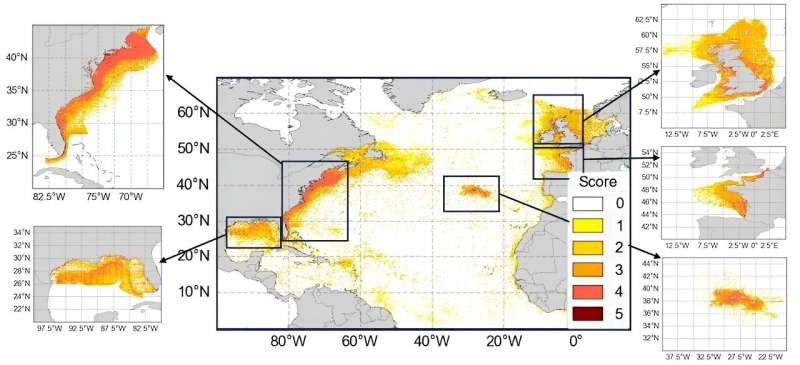Five hotspots where floating plastic litter poses the greatest risk to North Atlantic marine life

Plastic has been found in every single part of the ocean, from the surface to the seafloor and from the tropics to the poles. Land-based sources of plastic account for the majority of this pollution, with plastic bags, bottles, wrappers, food containers and cutlery among the most common items found.
These items are often buoyant and float on the sea surface. As they travel long distances, they get pushed by the wind, waves and currents. This means they have the potential to cause harm far beyond the country from which they originated. For example, land-based plastic waste from Indonesia has been shown to travel over 4,000km to the Seychelles.
As it travels, plastic litter can cause harm to wildlife. Megafauna (large marine animals) can eat or become entangled in it. Consuming plastic litter can block or damage the gastrointestinal tract of animals, causing significant health impacts or death.
While ghost fishing gear (lost fishing nets that float freely) is the most common entanglement threat to marine megafauna, they can also become entangled in land-sourced plastics such as plastic bags, frisbees, potato nets, elastic bands and other circular plastics. This can cause severe trauma to the animal, and in some cases entanglement causes death.
If plastic is transported towards the shore, it can get caught or lodged in shallow environments where it can entangle or cover plant or animal habitats, causing damage. Plastic entanglement can cause breakage, and if it covers a habitat it will restrict access to food or light.
At Plymouth Marine Laboratory, our team of marine researchers have developed a risk assessment approach to understand where this plastic litter could cause the most harm in the North Atlantic, and which countries that plastic originated from. Our research highlighted five areas of high risk—the US Atlantic, the US Gulf of Mexico, the UK, French Atlantic and Portuguese Azores.
Reducing risk
In our new study, we assessed the risk of land-sourced plastic litter to marine megafauna. That includes seabirds, whales and dolphins, seals and sea lions, manatees and dugongs, sharks and rays, tuna and billfish. We also assessed the risk to shallow water habitats including coral reefs, mangroves, seagrass beds, saltmarsh and kelp seaweed beds.
Using a particle tracking model, we tracked the flow of buoyant plastic litter released from the rivers of 16 countries bordering the North Atlantic between 2000 and 2015 using the most recent data available. Billions of virtual particles were released at the mouths of the rivers each month, with surface currents and wind used to drive their movement. After 15 years of tracking, our model showed us where plastic was likely to accumulate.
We also assessed the vulnerability of each of the megafauna groups and shallow water habitats to this plastic. For marine megafauna, we developed vulnerability scores by quantifying the amount of scientific evidence of ingestion or entanglement in land-sourced plastic. For habitats, we developed vulnerability scores by quantifying the scientific evidence available for this plastic causing harm by entanglement or smothering.
To assess risk, we mapped the vulnerability and distribution of each megafauna group or habitat against the abundance of plastic. Each point within the map was given a risk score from zero to five. The greatest risk occurred in areas where high numbers of vulnerable megafauna or habitats overlapped with high concentrations of plastic.
Managing the plastic problem
We found that much of the modeled plastic litter causing risk in the UK originated from UK rivers. In other high-risk zones such as the Azores and the US Gulf of Mexico, plastic primarily originated from other regions. More than 99% of plastic litter in the Azores was estimated to come from the other countries, mainly Caribbean islands and the US.
The potential of this plastic to travel vast distances across the ocean makes management of this pollutant particularly difficult. More than 90% of plastic waste in the Dominican Republic and Haiti are estimated to be mismanaged. This waste has the potential to cause ecological harm across both sides of the Atlantic.
UN member nations have agreed to forge an international legally binding agreement to tackle plastic pollution, called the Global Plastics Treaty, with negotiations expected to be completed by the end of this year. This study highlights the importance of the treaty in ensuring international cooperation to reduce plastic consumption and waste, including the provision of financial support to help lower-income nations such as the Caribbean islands implement measures. Identification of high-risk zones will also help prioritize areas where interventions and monitoring should be targeted.
Even if all plastic intervention measures are implemented, it is likely that substantial amounts of plastic will still enter our oceans. The production, sale and distribution of many of single-use items are likely to be phased out under the Global Plastics Treaty, as nations move to restrict avoidable plastic products.
While global measures are hugely important in the fight against plastic, the choices of consumers also play a significant role. Reducing, re-using and recycling plastic are powerful ways to cut your plastic footprint. At both ends of the spectrum, the choices made at international and household level can be good news for marine wildlife.
Provided by The Conversation
This article is republished from The Conversation under a Creative Commons license. Read the original article.![]()
No comments:
Post a Comment